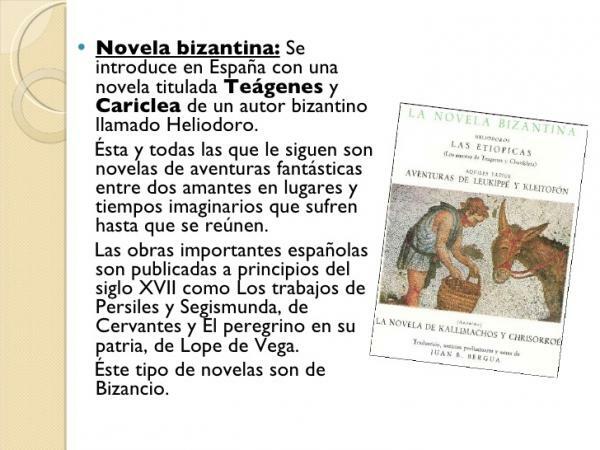Byzantine novel: characteristics and examples

During the Spanish Golden Age A new novel subgenre appeared that was framed within the fictional narrative. It is about the Byzantine novel, some texts written in prose that began to be cultivated in the Spain of the 16th and 17th centuries having as a source of inspiration the Greek authors, especially Heliodorus of That table. In this lesson from a TEACHER, we are going to discover you which are the main characteristics of the Byzantine novel and examples of works and authors featured; in this way, you will be able to know in depth what these literary works were like.
Before entering fully into the characteristics of the Byzantine novel, we believe that it is important to stop for a moment to define this type of literary text and to know what it exactly consists of. The byzantine novel It is also known by the name of "pilgrim adventure books" and it is a type of narrative text written in prose that was very popular in the Spain of the Golden age.
The origin of these novels must be sought in the
ancient greek literature; Above all, scholars emphasize the importance of a novel from the 3rd century AD and that it is considered the basis of this literary subgenre. We talk about The loves of Teagenes and Cariclea by Heliodoro de Émesa, a text that tells us about the adventures of a princess who falls in love with a young man and, together, they live a great number of adventures as they begin a journey full of obstacles.The authors of Spanish Byzantine novels were inspired by this and other Greek writings to, in the middle of the Golden Age, promote a new prose subgenre that placed us in exotic environments and where a lot of adventures took place that used to have a happy ending.

Image: Slideshare
To better understand what the Byzantine novel is, it is important to pay attention to the particular elements of this type of literary text. Therefore, below we are going to offer a compilation of the outstanding features of these writings so that, thus, you can learn to easily detect a text that falls within this subgenre.
The main characteristics of the Byzantine novel are as follows.
The same plot scheme
It is important to make clear that the vast majority of Byzantine novels have the same plot theme in which they are presents the story of two lovers who encounter a lot of obstacles to be able to have a relationship and / or get marry. The knot of the plot focuses on recounting how lovers overcome all trials and difficulties to end in a happy ending in which love is stronger than all things.
The journey as a common thread
The most important characteristic of the Byzantine novel is that in all these stories a journey took place. In fact, the journey itself was the knot of the story, the act that made the characters find themselves immersed in colorful adventures that could jeopardize their objectives. In addition, it is important to know some recurring symbology in this type of literary subgenre since the presence of the sea was the element that symbolized the instability of life.
In media res
We must also mention as an important characteristic that these novels present a narrative structure in media res. That is, the events are not told chronologically but the story begins to be explained towards the middle of the plot, when the conflict breaks out and, later, the author goes back in time to give answers to the doubts that he has generating.
The importance of chastity
One of the most interesting characteristics of the Byzantine novel is that young lovers promise to remain virgins until they can meet again. For this reason, we are facing a type of chaste and pure love in which religion is very present and that serves as a condemnation of other people who appear and paint themselves as "depraved." The fidelity of the lovers' feelings is tested at all times but they do not end up falling into temptation.
Moralizing vision
As we can see, the Byzantine novel had a clear ethical and moral functionality by showing two characters who presented themselves as the human "ideal". They were faithful, brave, and pure who did not allow themselves to be tempted by the pleasures of life or by the sins that could put them to the test.
The picaresque of the characters
A very interesting element of these literary texts is that, although the ethical and moral vision of life abounds, the characters carry out different tricks to be able to overcome the obstacles with which they are in the road. Thus, it is common to find stories in which the characters have had to resort to lies or deception through disguises or fallacies to be able to get out of a complicated situation. But this behavior is never condemned but is usually shown as the only possible way to escape the entanglement.
Happy ending
The vast majority of Byzantine novels have a happy ending. Lovers, after having lived through a lot of misadventures, meet again and can have a loving relationship full of happiness. They have kept their promise of fidelity and chastity, therefore, they have managed to overcome the temptations of the world. The way lovers recognize each other after such a long time is usually done through the anagnorisis technique, that is to say, some object from childhood helps them to recognize their lover who, over the years, has changed in appearance.
Genre with classical influences
We end with the characteristics of the Byzantine novel by talking about the relationship that exists between subgenre and Greek literature. As we have already commented, this type of text appeared during the Renaissanceand, therefore, the authors were inspired by classical sources to overcome the dark stage of the Middle Ages. This investigation into the past made the artists reconnect with Greek literature and, hence, with authors who were their inspiration for the creation of the Byzantine novel. The similarities between Greek and Byzantine novels there are many:
- Likelihood of action
- Spaces described in a very visual way to achieve greater realism
- Psychological depth of the characters
- Moralizing vision of life
- Exaltation of a pure and chaste kind of love

Image: Slideplayer
To finish this lesson we are going to show you some examples of Byzantine novels and their authors so that you can immerse yourself in reading any of these texts and discover first-hand what they are like and what their features. Here we leave you some of the best known Byzantine novel works in Spain.
- Clareo and Florisea's love story by Alonso Núñez de Reinoso: It is a Byzantine novel from 1552 that is inspired by the Greek novel by The loves of Leucipe and Clitophonby Aquiles Tacio.
- The works of Persiles and Sigismunda from Miguel de Cervantes: the famous Spanish author also tried his luck with the Byzantine novel by publishing this text in 1633. Here the author tells us the stories of a couple who have to fight to defend their love.
- History of Hipólito and Aminta by Francisco de Quintana: another example of a Byzantine novel is found in this work published in 1627. It was a very successful text and was edited up to 4 times. It is a more complex work in which different subplots are told that enrich the main story.
- The pilgrim in his homeland from Lope de Vega: the promoter of the new theater in Spain also published a text that falls within the Byzantine genre. In 1604 this work appeared in which the author made all the trips that appeared in the text be made within Spain.



